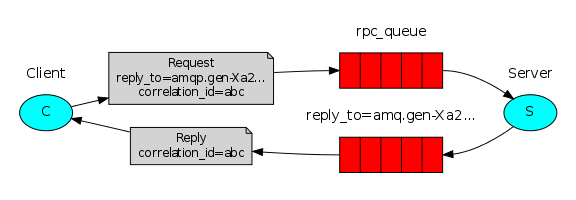Remote procedure call (RPC)
RPC简单的说就是,远程调用一个函数方法,并得到响应的结果。
关于RPC方法要注意的点:
- 明确什么函数需要写在本地,什么函数需要写在Remote
- 编写好响应的文档,明确调用关系
- 处理错误情况。什么时候客户端应该重新调用当服务端挂了。
- 消费RPC服务时,最好不要阻塞的方式等待结果,最好是异步的。
准备
- 在本地启动rabbit-server(3.6.1)
整体架构

我们的RPC是这样工作:
- 当客户端启动后,他将创建一个匿名的回调队列,用来存放服务的返回结果。
- 作为一个RPC请求,这个客户端发送的信息包括两个属性,replyTo:它指向回调队列。
correlationId:为每一个请求分配一个唯一的值,以备后面获取服务返回的值使用。
- 请求发送到rpc_queue队列上
- RPC worker(Server)监控rpc_queue的这个队列,消费上面的信息,将结果发送到replyTo指定的队列上。
- 客户端监控回调队列,通过correlationId取出属于自己的结果。
代码实现
maven GAV
| <dependency>
<groupId>com.rabbitmq</groupId>
<artifactId>amqp-client</artifactId>
<version>3.6.1</version>
</dependency>
|
客户端(client)
1
2
3
4
5
6
7
8
9
10
11
12
13
14
15
16
17
18
19
20
21
22
23
24
25
26
27
28
29
30
31
32
33
34
35
36
37
38
39
40
41
42
43
44
45
46
47
48
49
50
51
52
53
54
55
56
57
58
59
60
61
62
63
64
65
66
67
68
69
70
71
72
73
74
75
76
77
78
79
80
| [RPCClient] []
import com.rabbitmq.client.ConnectionFactory;
import com.rabbitmq.client.Connection;
import com.rabbitmq.client.Channel;
import com.rabbitmq.client.QueueingConsumer;
import com.rabbitmq.client.AMQP.BasicProperties;
import java.util.UUID;
public class RPCClient {
private Connection connection;
private Channel channel;
private String requestQueueName = "rpc_queue";
private String replyQueueName;
private QueueingConsumer consumer;
public RPCClient() throws Exception {
ConnectionFactory factory = new ConnectionFactory();
factory.setHost("localhost");
connection = factory.newConnection();
channel = connection.createChannel();
replyQueueName = channel.queueDeclare().getQueue();
consumer = new QueueingConsumer(channel);
channel.basicConsume(replyQueueName, true, consumer);
}
public String call(String message) throws Exception {
String response = null;
String corrId = UUID.randomUUID().toString();
BasicProperties props = new BasicProperties
.Builder()
.correlationId(corrId)
.replyTo(replyQueueName)
.build();
channel.basicPublish("", requestQueueName, props, message.getBytes("UTF-8"));
while (true) {
QueueingConsumer.Delivery delivery = consumer.nextDelivery();
if (delivery.getProperties().getCorrelationId().equals(corrId)) {
response = new String(delivery.getBody(),"UTF-8");
break;
}
}
return response;
}
public void close() throws Exception {
connection.close();
}
public static void main(String[] argv) {
RPCClient fibonacciRpc = null;
String response = null;
try {
fibonacciRpc = new RPCClient();
System.out.println(" [x] Requesting fib(30)");
response = fibonacciRpc.call("30");
System.out.println(" [.] Got '" + response + "'");
}
catch (Exception e) {
e.printStackTrace();
}
finally {
if (fibonacciRpc!= null) {
try {
fibonacciRpc.close();
}
catch (Exception ignore) {}
}
}
}
}
|
RPC服务端(RPCServer)
1
2
3
4
5
6
7
8
9
10
11
12
13
14
15
16
17
18
19
20
21
22
23
24
25
26
27
28
29
30
31
32
33
34
35
36
37
38
39
40
41
42
43
44
45
46
47
48
49
50
51
52
53
54
55
56
57
58
59
60
61
62
63
64
65
66
67
68
69
70
71
72
73
74
75
76
77
78
79
80
81
82
| [RPCServer] []
import com.rabbitmq.client.ConnectionFactory;
import com.rabbitmq.client.Connection;
import com.rabbitmq.client.Channel;
import com.rabbitmq.client.QueueingConsumer;
import com.rabbitmq.client.AMQP.BasicProperties;
public class RPCServer {
private static final String RPC_QUEUE_NAME = "rpc_queue";
private static int fib(int n) {
if (n ==0) return 0;
if (n == 1) return 1;
return fib(n-1) + fib(n-2);
}
public static void main(String[] argv) {
Connection connection = null;
Channel channel = null;
try {
ConnectionFactory factory = new ConnectionFactory();
factory.setHost("localhost");
connection = factory.newConnection();
channel = connection.createChannel();
channel.queueDeclare(RPC_QUEUE_NAME, false, false, false, null);
channel.basicQos(1);
QueueingConsumer consumer = new QueueingConsumer(channel);
channel.basicConsume(RPC_QUEUE_NAME, false, consumer);
System.out.println(" [x] Awaiting RPC requests");
while (true) {
String response = null;
QueueingConsumer.Delivery delivery = consumer.nextDelivery();
BasicProperties props = delivery.getProperties();
BasicProperties replyProps = new BasicProperties
.Builder()
.correlationId(props.getCorrelationId())
.build();
try {
String message = new String(delivery.getBody(),"UTF-8");
int n = Integer.parseInt(message);
System.out.println(" [.] fib(" + message + ")");
response = "" + fib(n);
}
catch (Exception e){
System.out.println(" [.] " + e.toString());
response = "";
}
finally {
channel.basicPublish( "", props.getReplyTo(), replyProps, response.getBytes("UTF-8"));
channel.basicAck(delivery.getEnvelope().getDeliveryTag(), false);
}
}
}
catch (Exception e) {
e.printStackTrace();
}
finally {
if (connection != null) {
try {
connection.close();
}
catch (Exception ignore) {}
}
}
}
}
|
总结
优点:
- 如果RPC服务太慢,你可以再启动一个服务端,会自动负载均衡
- 客户端只需要发送和接收一个信息,不需要同步调用服务。这样一个RPC服务请求只需要一次网络回路
遗留问题:
- 如果没有RPC服务在运行,客户端应该怎样重新请求
- 客户端是否应该有超时的RPC
- 服务端执行过程有一个异常是否应该抛给客户端
- 服务端信息校验等保护自己避免攻击的方法
